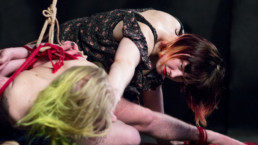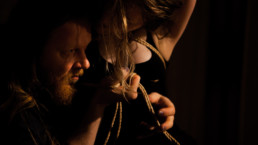Dear Addie, how did you get started with shibari?
I started with a partner who was interested and quickly discovered that I enjoyed it, both tying and being tied. I met Barkas a couple of years later at our local kink convention and things snowballed from there.
What is your approach to shibari?
As a person who ties, I want my tying partner to trust me, themselves, and the situation enough to relax the facade of socially acceptable speech and behaviours that we all wear to function in our societies. As a person who is tied, I look for the reciprocal state, moments or situations where I can drop the need to control or to behave, and let my mind or my body or my breathing react as they will. I want to find interactions where I lose track of time. As a person who self suspends, I want to push myself and see what I am capable of under pressure, and where the edge is, and how close I can get to it.
I look for the reciprocal state, moments or situations where I can drop the need to control or to behave, and let my mind or my body or my breathing react as they will.
Addie

Tell us about a constant that keeps you coming back to shibari?
It provides a space outside of day-to-day routine and preoccupation, where people can explore themselves. At its best, Shibari gives people the opportunity to be unscripted in their reactions, and to learn about themselves from the sources of those reactions.
Who are or what are you inspired by from practicing shibari?
Barkas has definitely been my largest influence and inspiration. They have a way of creating metaphors for rope practice that sound bizarre at first but end up making a lot of sense on further inspection. I love seeing what they will come up with next, and I love being along for the ride.
How do you continue to challenge yourself, within the frame of shibari, as it grows in popularity and attention?
I don’t really find its growth in popularity to be a problem, and it doesn’t negatively affect my personal practice. More interest and popularity has its pros and its cons (I think there are more pros) and as someone who teaches I am happy that there are people who want to learn, especially since I love teaching beginners. For myself, there are times of progress and then periods where I feel stagnant, then another period of growth, the same as learning any other craft. If I feel that I am in a period of stagnation then I take a break from tying for a couple weeks, and that tends to fix things. Pushing oneself to be constantly improving is impractical, especially as the better one is at a skill the smaller the progress steps are.
Pushing oneself to be constantly improving is impractical, especially as the better one is at a skill the smaller the progress steps are.
Addie
What are the things you love the most about shibari?
It has the potential to help people practice conscientious, kind, and impactful human interactions. Observing someone and trying to understand them requires a calm, supportive, patient empathy that we don’t necessarily have a chance to exercise in daily life, except perhaps with dear friends. Spending time trying to understand another helps exercise empathy muscles, so to speak, and that can only be a good thing. Exploring taboos (and bondage is certainly a taboo) also asks us to address what is uncomfortable in ourselves, and hopefully lets us deconstruct insecurities, biases, fears, and other dark bits that don’t often get examined.
What are the things you dislike the most about shibari?
It can be used in ways that I find highly unethical, for the benefit of one person at the expense of another. It requires physical and emotional vulnerability, and I think that people, generally very well-meaning people, sometimes run too deep too quickly and unearth things that they do not then have the time, energy, or support systems to deal with without undue distress.
What would you like to show/teach others about shibari?
This may sound cheesy but I think that giving someone the space to find and address the bits of themselves that they are most unsure of, and then celebrating those things with them, is a kind of love that builds people up, and that many of us don’t get enough of. I would like to show people how to practice sharing that type of affirmation, of caring for someone including their flaws, not in spite of them.
Name some of your essential resources:
Barkas, definitely. I’ve learned most of what I know about rope from them, though I have my own way of using some of those tools. Other than that, lots of conversations with lots of people, and years of seeing a variety of good or less good situations in rope. That collection of experiences, which is still growing, is the basis for most of what I believe matters in Shibari.


